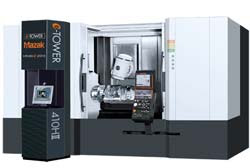
A CNC machine tool is a powered mechanical device used to fabricate metal components of machines by the selective removal of metal. The term machine tool is usually reserved for tools that used a power source other than human movement, but they can be powered by people if appropriately set up. Many historians of technology consider that the true machine tools were born when direct human involvement was removed from the shaping or stamping process of the different kinds of tools. For instance, they consider that lathe machine tools were invented around 1751 by Jacques de Vaucanson because he was the first to mount the cutting instrument on a mechanically adjustable head, taking it out of the hands of the operator.
Related equipment and machinery: CNC vertical machining center, cnc horizontal machining center, CNC turning center, CNC rotary table and indexers, Automation Production and manufacturing, Stewart platform, Drills, EDMs, Lathes, Milling machines, Wood routers , Sheet metal works Hot-wire foam cutters Plasma cuttings Water jet cutters Laser cutting Oxy-fuel CNC turning centers, vertical machining centers, horizontal machining centers, Multi-Tasking machines, 5-axis machines mill drill CNC VMC technology HMC rotary tables CAD CAM lathes, vertical horizontal machine tools, 5-axis, cnc magazine, computer numerical control, mold machine, toolroom mill FMS, gantry, pallet changer, trunnion, spindle, g-code, metalcutting, metalworking, milling machines, Collet lathes, machine tools, mill, milling center, indexer, rotary, machinery, automation. cnc router. wood cnc router. table top cnc router. plastic cnc router. low cost cnc router. cnc router video. cnc video. cnc router pics. cnc router images. video of cnc router. cnc router images. CAD CAM software. cnc plasma. cnc router control. cnc router table. cnc router cutting. cnc router in USA. small cnc router. cnc router machines. cnc router for milling. Guitar making cnc. artcam. cnc wax. cnc router for wax. cnc routers for jewelry. cnc routers for rings. cnc routers 4th axis. cnc routers servo. cnc routers steppers. cnc routers for aluminum. cnc routers for brass. cnc plasmas for metals. cnc plasmas with hypertherm. cabinet cnc routers mdf cnc routers computer numeric controlled computer milling computer aided designing computer aided machining machining was cnc numeric control linear motion Vector Art for cnc Relief Aat for cnc
Related equipment and machinery: CNC vertical machining center, cnc horizontal machining center, CNC turning center, CNC rotary table and indexers, Automation Production and manufacturing, Stewart platform, Drills, EDMs, Lathes, Milling machines, Wood routers , Sheet metal works Hot-wire foam cutters Plasma cuttings Water jet cutters Laser cutting Oxy-fuel CNC turning centers, vertical machining centers, horizontal machining centers, Multi-Tasking machines, 5-axis machines mill drill CNC VMC technology HMC rotary tables CAD CAM lathes, vertical horizontal machine tools, 5-axis, cnc magazine, computer numerical control, mold machine, toolroom mill FMS, gantry, pallet changer, trunnion, spindle, g-code, metalcutting, metalworking, milling machines, Collet lathes, machine tools, mill, milling center, indexer, rotary, machinery, automation. cnc router. wood cnc router. table top cnc router. plastic cnc router. low cost cnc router. cnc router video. cnc video. cnc router pics. cnc router images. video of cnc router. cnc router images. CAD CAM software. cnc plasma. cnc router control. cnc router table. cnc router cutting. cnc router in USA. small cnc router. cnc router machines. cnc router for milling. Guitar making cnc. artcam. cnc wax. cnc router for wax. cnc routers for jewelry. cnc routers for rings. cnc routers 4th axis. cnc routers servo. cnc routers steppers. cnc routers for aluminum. cnc routers for brass. cnc plasmas for metals. cnc plasmas with hypertherm. cabinet cnc routers mdf cnc routers computer numeric controlled computer milling computer aided designing computer aided machining machining was cnc numeric control linear motion Vector Art for cnc Relief Aat for cnc
Blogs Directory




